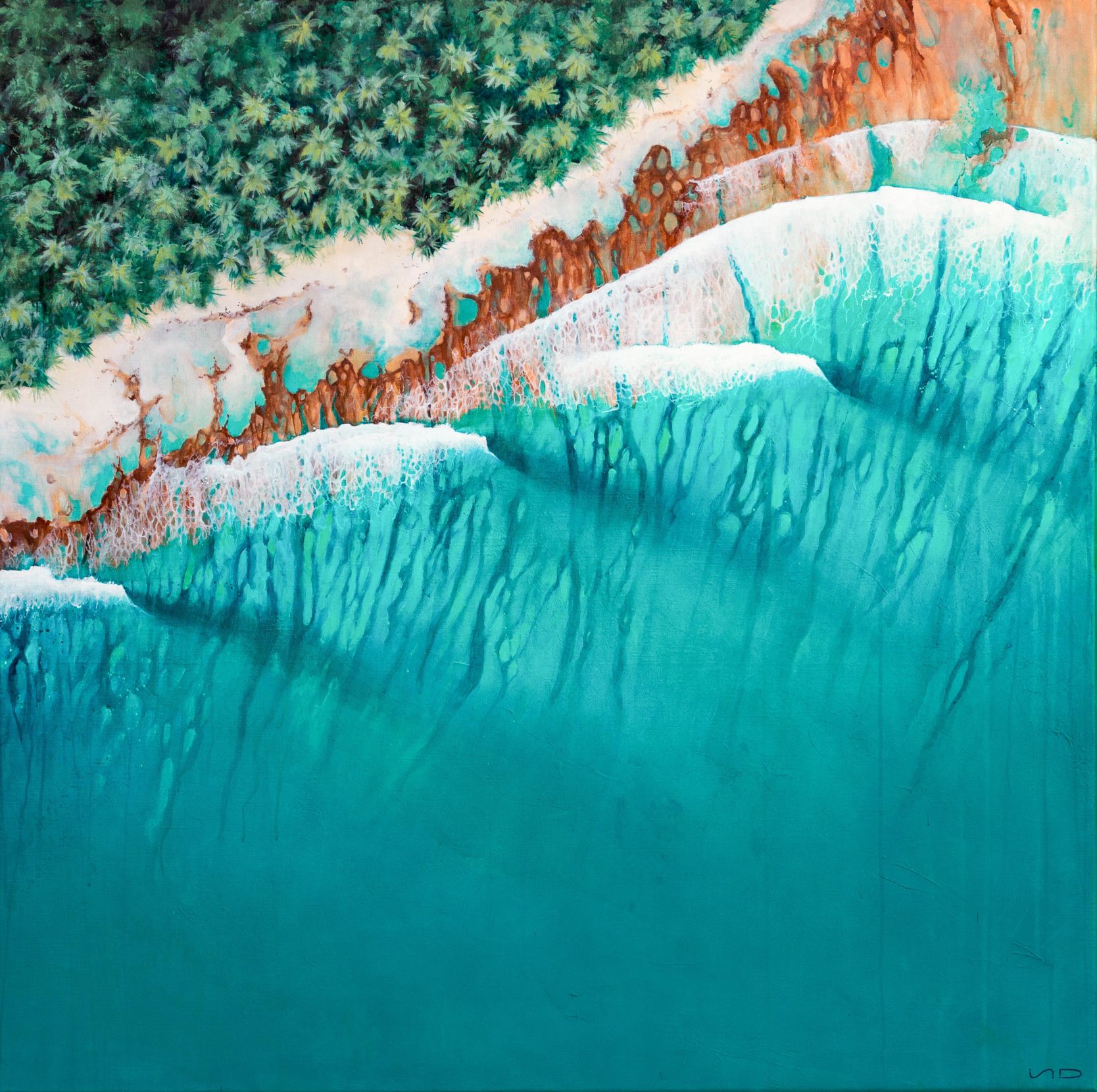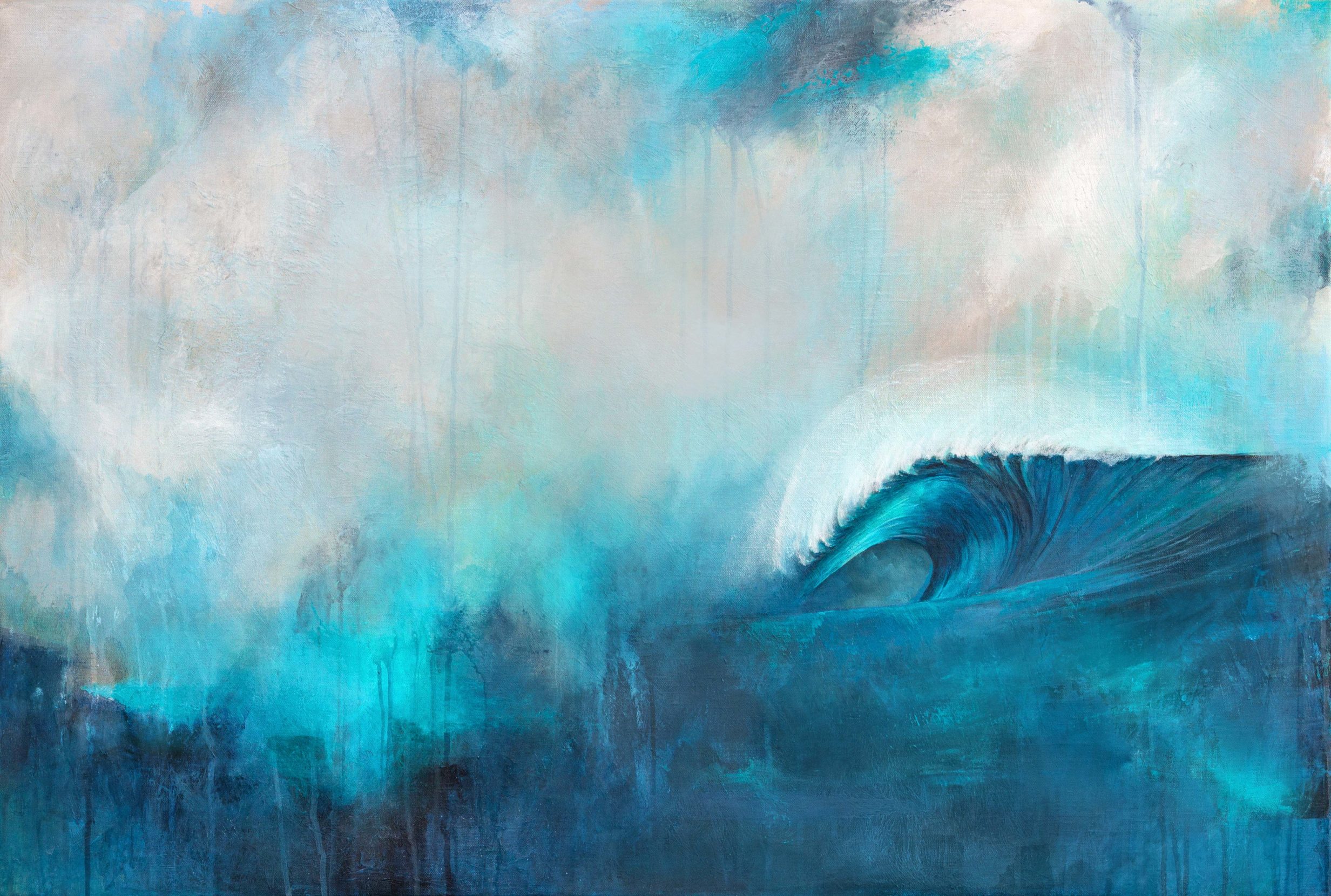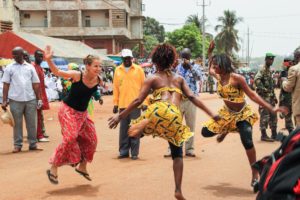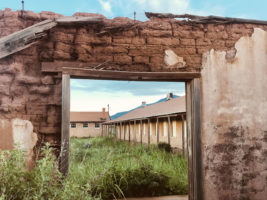Support Hidden Compass
We stand for journalism, science, history, and hope. Make a contribution to Hidden Compass and stand with us.
Given the picture-perfect day, the narrow Oahu beach was peculiarly empty. A pair of newlyweds had the entire panorama as backdrop for their wedding photos. Far from shore, streaks of cirrus clouds formed a cross in a cobalt sky that met the white foam of the break. The rainbow arcs of parasails spun their stick figure riders like marionettes.
The water was the aqua blue of my dreams, but I couldn’t enjoy it. Turning away from the waves, I kept my eyes fixed on the bride and groom as they cycled through predictable romantic postures. We didn’t say a word, but I could feel my husband watching them, too.
We were steeling ourselves — for the unpredictability of the water, and for the challenge that awaited us there.
Though we are both highly educated, financially stable, middle-aged parents, my husband and I often feel paralyzed by both real and imagined consequences — the jeopardy of our skin. For a Black woman like me, the double bind of intersectionality has an even more intimate impact. Thrill-seeking, leisure-driven behavior isn’t in my lexicon.
How, then, do I explain my impulse to surf?
~~
I am 4 and preparing to go down the water slide at the Hilton Hawaiian Village. I can’t swim.
The slide looks to be surrounded by volcanic rock. Scaling to the top is like scaling a volcano. My father waits below in the pool, where the slide spits out in foam. He tells me to come down. I trust him and I do. But I do not splash into his arms. I fall so fast I hit the bottom of the pool. Water rushes into my nose, ears, and mouth.
Stupefied, I watch sunlight slit the watery ceiling until I am snatched, sputtering into the air.
The first thing I hear is my mother yelling at my father.
“You weren’t paying attention,” she says.
“She slipped right through my hands,” he replies.
I remember the speed of the slide and the water closing over my head, sealing me under.
How, then, do I explain my impulse to surf?
~~
“Daddy taught every one of us to swim by picking us up when we was little, around six or so, and flinging us in the water,” recounts Esch, the 13-year-old motherless girl at the center of Jesmyn Ward’s novel, Salvage the Bones. “I’d taken to it fast, hadn’t coughed up the muddy pit water, hadn’t cried or flailed … I’d pulled the water with my hands, kicked it with my feet, let it push me forward.”
Unlike Esch, I did not find a natural equilibrium with water, though eventually I learned enough swimming basics to stay afloat. Even having never fully shaken my childhood fear of going under, wild water captivates me. I love watching rapids split over and around boulders, or sea foam caught in tide pools.
Just before I headed to Hawaii for an academic conference, four decades after my first visit, I finally committed to learning the proper technique for freestyle, along with a steady rhythm and a proper arm curvature that strengthened my stroke.
I had become determined to take a surfing lesson.

Painting by Scott Denholm.
~~
In Compton, California, where my husband grew up, surfing was not something Black boys or girls did. Surfing was for the white daredevils who lived in Venice Beach and Malibu. He didn’t learn how to swim until college, when he had to pass a swimming test to graduate from Howard University.
In Madison, Wisconsin, where we raised our sons, midsummer means All-City — a swim meet that convenes teams from both private and public pools. It’s practically a municipal holiday.
When my boys were 8 and 11, we joined the nearest pool to us, and I suggested they try out for its swim team, the Shorewood Sharks. Downtown Madison is located on an isthmus surrounded by four lakes. Swim team would be the best way to ensure they mastered the four basic strokes: freestyle, backstroke, butterfly, and breaststroke.
A more pernicious anxiety coursed below my not-so-subtle pressure. According to the CDC, African American children between 10 and 14 years old are almost eight times more likely to drown in swimming pools than their white counterparts. Socio-economic barriers factor into the risk, as does the legacy of trauma associated with the violent and often humiliating enforcement of segregation in public pools.
My boys vigorously resisted. When I asked why, both looked at the ground. Finally, my youngest said, “We don’t want to stand out.”
Swim meets require long hours poolside, and we were perennially the only Black family on sidelines rife with racial awkwardness.
To participate felt like trespassing.
We didn’t push them. Instead, we did two years of lessons every morning in June, until they were competent swimmers.
By the time they were teenagers, my boys still loved going in the water on family vacations, but they no longer wanted to go to the pool. They disliked the teenage lifeguards who scolded them on bullhorns to “Walk, don’t run” — singling them out for infractions often overlooked in their white peers.
Their bodies, once adorably brown, had become lean, lanky, and foreign in that space. At swimming pools, barely clothed bodies exchange fluids in the water and brush up against each other. As Jeff Wiltse, author of Contested Waters: A Social History of Swimming Pools in America, noted in an NPR interview: “Racial segregation occurred at the exact moment that gender integration occurred.”
Within that context, my boys were uniquely vulnerable, especially in a culture that continues to see Blackness as other, dangerous, and contaminating.
~~
The beach bride and groom finished their photo shoot and departed on a moped decorated with peach-colored balloons. I watched them speed off until I could no longer see her iridescent veil, which she held in place with her left hand as the veil streamed behind her. My husband touched my shoulder, and together we walked to a grassy patch at the edge of the beach near the parking lot — the designated meeting site for our beginner surf lesson.
Thrill-seeking, leisure-driven behavior isn’t in my lexicon.
Our instructors were unloading boards and other equipment from a company van painted with a bright blue wave. Joining us in our semi-private lessons were newlyweds from Boston in matching black wet suits.
With my turquoise and black rash guard and honey-colored box-braids, I was channeling my inner Black Gidget.
I had long sworn I would never go blond, but the multibillion-dollar Black hair industry nailed the perfect shade of sunshine for my complexion. While the color was perfect, the texture was itchy, and the chemicals it was treated with gave me a rash. After several apple-vinegar washes and two return trips to the salon, the braids finally felt as good as they looked, and yet, when they got wet, their absorbed moisture gave me a splitting headache. In preparation for the lesson, I’d wound them into a large topknot.
One of our instructors — a wispy, blond nursing student named Rosalie — gave me a long, assessing look, then handed me a pair of thick leggings to pull up over my bathing suit. Our other instructors included two very chill, patient men. One was a Hawaiian local, that mix of Japanese/Filipino/Polynesian often classified as Asian-Pacific — a bronze Keanu Reeves with a (1991) Point Break affect. The other resembled the SNL comic Pete Davidson, complete with arm tattoos and a caustic sense of humor.
Once I’d activated Black Gidget mode, I couldn’t resist assigning similarly inflected caricatures to my co-stars.
I chose this company because my guidebook told me it was woman-owned. I didn’t want to be judged or ogled by a surf-instructor stereotype I couldn’t shake: an amalgam of Baywatch lifeguards and flannel-shirt wearing stoners I went to high school with in Santa Monica. The latter had loitered outside our bungalows like clichés come to life, reeking of pot, sunscreen, and chauvinism.
Even after I developed a more nuanced understanding of working-class enclaves adjacent to affluent beach communities (see the 2001 documentary Dogtown and Z-Boys), I still understood surfing as a white, male cultural appropriation.
To participate felt like trespassing.
~~
Days before we arrived on that Oahu beach, my husband and I had hiked to Manoa Falls. Heavy rains suffused the trail with mud, but this did not deter the stoic crowds spraying clouds of DEET into the viscous air.
The scenery evoked a lush Jurassic world, but my most salient memory is of a fellow hiker. During our descent, as we gingerly and politely pressed ourselves against slippery rocks to allow those ascending the narrow path to pass by, a man strode by holding a baby vertically against his chest with the palm of one hand, his faith in his footing secured by flip-flops.
He had no child carrier like the back brace my husband strapped on when our boys were toddlers. A few steps behind, a woman with a tight smile kept pace with his shoulder. I couldn’t keep the disgust from my face.
My husband said: “That baby isn’t working hard enough.”
I can’t remember the man’s response. Did he laugh off the joke that wasn’t a joke, or did he perceive the implicit critique? For a split second, the woman (the child’s mother?) met my eyes. Her hostility caused me to look away.
Encountering that baby, worn by his father like a floating accessory, had reminded me how race forces us to differentially factor risk. For Black parents, even trivial decisions are freighted with apprehension.
A friend, who happens to be a woman of color in an interracial marriage, put it this way:
“My husband’s whiteness is our patronus,” she said, referencing the most formidable spell in the (Harry) Potterverse.
At the time, I laughed at her prescient comparison of his privilege to wizardry. Upon reflection, I sensed an undercurrent of bitterness. The feeling that for some of us, safety nets are made of straw.
~~
In the annals of mid-century surf history, there is a notable exception: Nick Gabaldón: a surfer of African American and Latino descent with a debonair profile more befitting a Motown crooner than a wave rider. In the 1940s, West Coast beaches were still segregated by practice if not by law. The daredevil culture and seductive waves beckoned to Gabaldón, who regularly swam 12 miles from Santa Monica to Malibu to perfect the practice he loved.
Encountering that baby, worn by his father like a floating accessory, had reminded me how race forces us to differentially factor risk.
On a fateful day, his decision to “shoot the pier,” to ride a wave between the pilings, had tragic consequences. After hitting his head on wooden supports beneath the jetty, he disappeared, his body recovered days later.
Gabaldón’s memory is kept alive by a few hazy photographs and memories of those who admired his muscular physique, marveled at his acumen, and found some comfort that he died doing what he loved. His legacy inspired the Black Surfer Collective, which didn’t exist when I was growing up in L.A.
Eerily, days before his death, Gabaldón wrote his own epitaph:
… The sea vindictive, with waves so high
For men to battle and still they die.
Many has it taken to its bowels below;
Without regard it thus does bestow
Its laurels to unwary men.
… Scores and scores have fallen prey
To the salt of animosity;
And many more will victims be
Of the capricious, vindictive sea.
~~
Flipping through the pages of AFROSURF reveals a Black, diasporic aquatic culture that appears to have found balance between the swells. The collection of essays, images, and poems documents the surfing traditions of Africa, which developed along swaths of the continent’s west coast co-terminus with Polynesian wave-riding. The earliest account of surfing anywhere, according to the book, comes from a 1640s account written in Ghana.
Published by a South African surf company named Mami Wata after a water spirit known on both sides of the Atlantic, AFROSURF features pictures of children using the Ghana coast as an aquatic playground.
This coast that launched thousands of slave ships.
The juxtaposition perplexed me. But the longer I gazed at stunning photos of professional and amateur African surfers, I felt I could hear their cleansing laughter. It was a visual album created in defiance of the images of the American surfers promulgated by Baywatch and the Beach Boys. The glossy portraits of adults and children alike — clustered with boards at the ready, studying the waves — evinced a euphoria and daring I had long imagined inaccessible.
~~
Once the longboards had been assigned and laid out on the grass, Keanu took over the instruction. He demonstrated where to position our bodies for maximum stability and how to raise up from all fours into a crouching stance. Rosalie modeled how to push up into upward facing dog in order to crest over the waves. As I mimed her movements, I noticed the curving muscles in her biceps.
After a five-minute lesson, we paddled out into the water.
The Boston wife said to her husband: “I thought we would begin in the shallows.”
He laughed it off. But I’d had the same idea. Boogie-boarding before catching real waves. In this, we were all mistaken.
“We learn by doing,” Keanu said.
~~
Toni Morrison’s Paradise is about the lengths a community will go to preserve its gains when threatened. From its shocking opener: “They shoot the white girl first,” a story unspools that obscures and cloaks the racial identifiers of one community, while the adjacent, all-Black town of Ruby maintains a hierarchy based on color and gender.
Ruby — the post-reconstruction, “hard-won heaven” at the center of the novel — is haunted by the fates of other Black settlements like Tulsa, where, a hundred years ago, Black excellence placed the town in the bull’s-eye of the neighboring, working-class white community. Because of a rumor of an interracial encounter between a Black man and a white female elevator operator, mob violence incinerated the affluent Black enclave, which boasted its own movie theater, thriving business, and graceful homes.
With that history in their minds, Ruby’s founding fathers do not hesitate to do battle, even if it means “saving” their women from the radical feminism so brazenly practiced by the runaway women at the nearby Convent.
Morrison imagined an unlikely community of women forging new pathways for how to face the world — on their terms, at considerable risk.
~~
My board was so gigantic I needed help to carry it into the water. The longboards’ size made them particularly stable at sea, and particularly cumbersome on land.
As I paddled away from the sand, I was not thinking about the depth of the water, or that this was the farthest from shore I’d ever been without a personal flotation device. I focused on keeping up with Rosalie and where to position my body on the board.
When I made the online reservation, there was what I considered to be an irrelevant question about weight. As always, I shaved off 10 pounds, but now I wondered if that was a critical error. The effort it took to paddle swallowed any lingering panic as we crept farther and farther, until the shoreline and everyone on it seemed like a mirage.
Each time I listened for Rosalie’s cue, I thought, This will be the one. Of the four waves I caught, I reached the crouching stance three times. Doing so took an extraordinary amount of faith in muscles I didn’t know I had and an unwavering awareness of movement of the water beneath.
The first time, I angled wrong as I fell out of position, banging my chin on the board as I went down. The second time, I failed to hear Rosalie’s command to stand up and bodysurfed a huge wave out of the sight line of the instructors.
The large break pushed me back to the shallows. It took all my effort to swim back to the group.
Alone, I paddled over the swells. Spray stung my eyes as I ducked under or glided above the waves, always conscious of the reef on my right side as the currents corkscrewed on the left.
I imagined the water as empty as the sky. I let go of the shadowy congregation of reef sharks, sharpened coral, and ensnaring riptides. I called on Mami Wata as a spiritual buoy. I held on and didn’t stop swimming until I spied two clusters of heads bobbing and treading water in the trough.

Painting by Scott Denholm.
~~
Later, my husband told me that the instructors were “visibly concerned,” by my disappearance, intermittently scanning the water and exchanging hand signals he couldn’t decipher.
“What was frustrating,” he said, “was that I couldn’t help you if you were in trouble. I had to focus all my energy keeping myself afloat.”
My husband isn’t flexible. I felt guilty watching him cling to his board, unable to lift his head because of his stiff neck.
If you aren’t a trained lifeguard, it can be deadly to attempt to save a drowning person. They can inadvertently pull you under. There’s that familiar expression: crabs in a barrel. Meaning you can entrap crustaceans without a top because if one attempts to climb out, the others will pull them back down. None prevail.
~~
At the end of our lesson, Pete placed his feet over our long boards and towed us in, taking periodic breaks to rest.
“It’s always fun to paddle out,” he said. “I’m thinking about the waves I’m going to catch. But coming in is exhausting. You’ve lost that adrenaline rush.”
Later in the week, we would drive to Sunset Beach and watch wave riders surf the pipe sideways instead of perpendicular. Their flimsy boards looked like skateboards next to our rafts. Delusions of competency vanished.
But that day, our group emerged from the water hungry and sore and puffed up with a shared sense of satisfaction. I had been so focused, I’d forgotten about the newlyweds in their matching wet suits — until the Boston husband put his arm around his shivering wife and said, “We couldn’t come all the way to Hawaii and not surf.”
No preparation or calculations needed: just something to do on an off afternoon, a box checked.
~~
Hours later, I soaked my lower body in our hotel bathtub. The insides of my biceps were raw with raised, red welts from board rash.
While leaning my Desitin-coated arms outside the tub, I began to comprehend how actively the instructors had managed our experience. They were constantly watching the shifting swells and currents, towing and paddling, and determining which waves to catch and which weren’t worth the trouble. “Turn around,” they said, giving us a hard push, then shouting, “Stand up.” Relocating us when we got too close to the reef.
At one point, while waiting in the trough, I had seen my husband stand up, and I had felt so proud of us. We had taken a chance and had the waves virtually to ourselves on a shamelessly beautiful day, when the current was moderately strong and breaking erratically.
On our own this would not have been possible. Much of surfing is reading the waves. The positioning techniques our instructors demonstrated barely scratched the surface.
I imagined the water as empty as the sky. I let go of the shadowy congregation of reef sharks, sharpened coral, and ensnaring riptides. I called on Mami Wata as a spiritual buoy.
What is freedom if not to chase our dreams? To embrace risk. To put our faith in minor gods.
We had reveled in the fleeting rush of being lifted by Gabaldón’s capricious sea — and then delivered safely back on land.
~~
The last time I had risen to my feet on the longboard, I did not look around. I knew the wave was unfolding beneath the soles of my feet and made the micro-adjustments necessary to stay on as long as possible.
Time attenuated. Seconds felt like minutes.
At the end of Paradise, gunfire has dispersed the wild women of the Convent, but Morrison leaves us with a lasting image of hope: “In ocean hush a woman black as firewood is singing. … Around them on the beach, sea trash gleams.”
But that’s not what comes to me on the board. Instead, I think of the Ghana surfers, of Mami Wata, and a wild, rogue sensibility that Morrison attributes to the feminine divine. No longer fearful, I am buoyant and loose, the water beneath solid enough to bear my weight.
Cherene Sherrard
Originally from Los Angeles, Cherene Sherrard is a poet, scholar, and essayist.
Never miss a story
Subscribe for new issue alerts.
By submitting this form, you consent to receive updates from Hidden Compass regarding new issues and other ongoing promotions such as workshop opportunities. Please refer to our Privacy Policy for more information.



